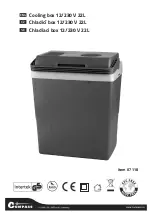
6
Operation and Maintenance Instructions
Fan System
The fan systems of both centrifugal and axial driven units
are rugged; however, the fan system must be checked
regularly and lubricated at the proper intervals. The following
maintenance schedule is recommended.
Fan Motor Bearings
EVAPCO evaporative cooling units use either a totally
enclosed air over (TEAO) or a totally enclosed fan cooled
(TEFC) fan motor. These motors are built to “Cooling Tower
Duty” specifications. They are supplied with permanently
lubricated bearings and special moisture protection on the
bearings, shaft and windings. After extended shut-downs, the
motor should be checked with an insulation tester prior to be
restarted.
Fan Shaft Ball Bearings
For induced draft units, lubricate the fan shaft bearings every
1,000 hours of operation or every three months for induced
draft units. Lubricate the fan shaft bearings every 2,000 hours
of operation or every six months for forced draft units. Use any
of the following synthetic waterproof, inhibited greases which
are suitable for operation between -29°C and 177°C. (For
colder operating temperatures, contact the factory).
- Mobil - Polyrex EM
- Timken Pillowblock Grease
- Chevron - SRI
Feed grease slowly into the bearings or the seals may be
damaged. A hand grease gun is recommended for this
process. When introducing new grease, all grease should
be purged from the bearings.
Most EVAPCO units are supplied with extended grease lines
to allow easy lubrication of the fan shaft bearings as shown in
Table 1
.
Fan Shaft Sleeve Bearings
(1,2 m LS units only)
Lubricate the intermediate sleeve bearing(s) before unit start
up. The reservoir should be checked several times during
the first week to ensure that the oil reserve is brought to
full capacity. After the first week of operation, lubricate the
bearing(s) every 1.000 hours of operation or every three
months (whichever occurs first).
Use one of the following industrial grade, non-detergent mineral
oils.
Do not use a detergent based oil or oils designated
heavy duty or compounded
. Different oils may be required
when operating at temperatures below 0°C continuously.
Table 1
provides a short list of approved lubricants for each
temperature range.
Ambient Temp
Texaco
Mobil
Exxon
Total
-32°C to 0°C
-
DTE Heavy
-
-
-17°C to 43°C
-
-
-
-
0 to 38°C
Regal R&O 220
DTE Oil BB
Teresstic 220
-
All bearings used on EVAPCO equipment are factory adjusted
and self aligning. Do not disturb bearing alignment by
tightening the sleeve bearing caps.
Fan Belt Adjustment
(Direct drive units do not re-
quire any adjustment)
The fan belt tension should be checked at start up and again
after the first 24 hours of operation to correct for any initial
stretch. To properly adjust the belt tension, position the fan
motor so that the fan belt will deflect approximately 10 mm
when moderate pressure is applied midway between the
sheaves. Belt tension should be checked on a monthly basis.
A properly tensioned belt will not “chirp” or “squeal” when the
fan motor is started.
Gear Drives
Induced draft units with gear drive systems require special
maintenance. Please refer to the gear manufacturers
recommended maintenance instructions. These will be
enclosed and shipped with the unit.
Air Inlet
Inspect the air inlet louvers (induced draft units) or fan screens
(forced draft units) monthly to remove any paper, leaves or
other debris that may be blocking airflow into the unit.
Coil Inlet
Inspect the top coil, air inlet and spray section on all PHC-E
units monthly.
Fan System - Capacity Control
There are several methods for capacity control of the
evaporative cooling unit. Methods include: Fan motor
cycling, the use of two speed motors, and the use of variable
frequency drives (VFD’s).
Note: for the eco-ATW with Sage
2
and eco-ATWE with Sage
3
consult the manual.
1. Fan Motor Cycling
Fan Motor Cycling requires the use of a single stage
thermostat which senses the fluid temperature (closed
circuit coolers) or condensing temperature (evaporative
condensers). The contacts of the thermostat are wired in
series with the fan motor’s starter holding coil.
For individual fan motor cyclings interlock fan motors
before fan start to prevent issues with reversing idle fans.
In this method, there are only two stable levels of
performance: 100% of capacity when the fan is on, and
approximately 10% of capacity when the fan is off.
Please note that rapid cycling of the fan motors can cause
the fan motor to overheat.
Controls should be set to only allow a maximum of six
start/stop cycles per hour.
IMPORTANT:
THE RECIRCULATION PUMP MAY NOT BE USED AS A
MEANS OF CAPACTY CONTROL AND SHOULD NOT BE
CYCLED MORE THEN SIx START/STOP CYCLES PER HOUR.
ExCESSIVE CYCLING CAN LEAD TO SCALE BUILD-UP,
RESULTING IN REDUCED WET AND DRY PERFORMANCE.
Table 1
– Sleeve Bearing Lubricants

























